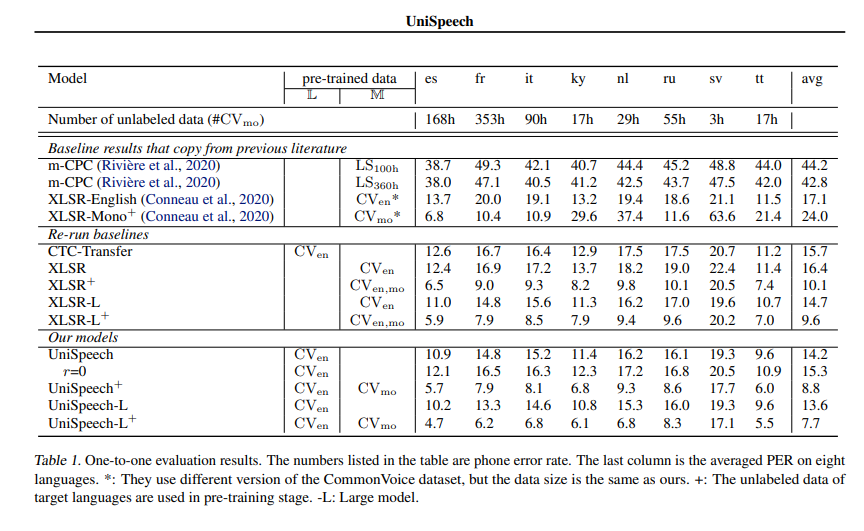🚀 UniSpeech-Large-plus Spanish
A pre - trained speech model fine - tuned on Spanish phonemes, leveraging Microsoft's UniSpeech technology for accurate automatic speech recognition.
🚀 Quick Start
This model is a large - scale model pre - trained on 16kHz sampled speech audio and phonetic labels, and then fine - tuned on 1 hour of Spanish phonemes. When using the model, ensure that your speech input is also sampled at 16kHz and your text is converted into a sequence of phonemes.
The original Microsoft's UniSpeech is a unified pre - training approach for learning speech representations with both unlabeled and labeled data.
Paper: UniSpeech: Unified Speech Representation Learning with Labeled and Unlabeled Data
Authors: Chengyi Wang, Yu Wu, Yao Qian, Kenichi Kumatani, Shujie Liu, Furu Wei, Michael Zeng, Xuedong Huang
Abstract
In this paper, we propose a unified pre - training approach called UniSpeech to learn speech representations with both unlabeled and labeled data, in which supervised phonetic CTC learning and phonetically - aware contrastive self - supervised learning are conducted in a multi - task learning manner. The resultant representations can capture information more correlated with phonetic structures and improve the generalization across languages and domains. We evaluate the effectiveness of UniSpeech for cross - lingual representation learning on public CommonVoice corpus. The results show that UniSpeech outperforms self - supervised pretraining and supervised transfer learning for speech recognition by a maximum of 13.4% and 17.8% relative phone error rate reductions respectively (averaged over all testing languages). The transferability of UniSpeech is also demonstrated on a domain - shift speech recognition task, i.e., a relative word error rate reduction of 6% against the previous approach.
The original model can be found under https://github.com/microsoft/UniSpeech/tree/main/UniSpeech.
✨ Features
- Trained on 16kHz sampled speech audio and phonetic labels.
- Fine - tuned on 1 hour of Spanish phonemes.
- Suitable for automatic speech recognition tasks in Spanish.
📦 Installation
No specific installation steps are provided in the original document.
💻 Usage Examples
Basic Usage
import torch
from datasets import load_dataset
from transformers import AutoModelForCTC, AutoProcessor
import torchaudio.functional as F
model_id = "microsoft/unispeech-1350-en-168-es-ft-1h"
sample = next(iter(load_dataset("common_voice", "es", split="test", streaming=True)))
resampled_audio = F.resample(torch.tensor(sample["audio"]["array"]), 48_000, 16_000).numpy()
model = AutoModelForCTC.from_pretrained(model_id)
processor = AutoProcessor.from_pretrained(model_id)
input_values = processor(resampled_audio, return_tensors="pt").input_values
with torch.no_grad():
logits = model(input_values).logits
prediction_ids = torch.argmax(logits, dim=-1)
transcription = processor.batch_decode(prediction_ids)
📚 Documentation
This is an speech model that has been fine - tuned on phoneme classification.
🔧 Technical Details
The model is based on Microsoft's UniSpeech, which uses a unified pre - training approach. It combines supervised phonetic CTC learning and phonetically - aware contrastive self - supervised learning in a multi - task learning manner. This allows the model to capture information more correlated with phonetic structures and improve generalization across languages and domains.
📄 License
The official license can be found here
📊 Official Results
See UniSpeeech-L^{+} - es:

👥 Contribution
The model was contributed by cywang and patrickvonplaten.

